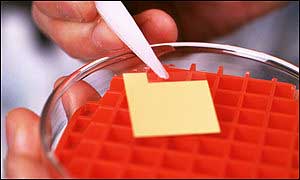




(Source: courtesy of Google)
Moore's Law predicted that microprocessors would double in power and the price remains the same every eighteen months. Until now he has been right. But soon scientists believe that microprocessors, made of silicon, will reach their limit. Because they wont be able to fit any more electronic components on to the silicon chips and the limit of miniaturization has nearly been reached. To be able to keep producing faster computer speeds they need to find a new material. DNA (Deoxyribonucleic Aid) is a likely candidate for the future of microprocessors.
DNA computing
(Source: courtesy of the BBC)
DNA molecules integrated into a computer chip has the potential to outperform the super computers of today, and will be able to store billions of data, more than is possible at this time. In 1994, a computer scientist Leonard Adelman suggested that DNA could solve complex mathematical problems.
DNA biochip
(Source: courtesy of the BBC)
The computing potential of DNA is immense and it has been estimated that a gram of dried DNA can hold as much information as a trillion CD's. Compared to a conventional computer a DNA computer with 10 trillion molecules, that fit in to one cubic centimetre, could hold 10 terabytes of data and perform 10 trillion calculations at one time. This technology is still in development, and perhaps in the next decade we could be using faster, more powerful and smaller computers in our homes. Moreover, possibly Moore's Law will continue.
To be able to use this technology you will need a VDSL transceiver in your home and a VDSL gateway in your telephone junction box. The data from your receiver is converted into pulses of light, that are transmitted over a fiber-optic system. This data is routed over the network until it reaches its final destination. When the data is sent back to your computer, the gateway converts the signal from the fiber-optic cable and sends it to the transceiver. All of this happens millions of times each second.
![]()